

SysPlay eLearning Academy for You. Device Drivers, Part 1: Linux Device Drivers for Your Girl Friend - Open Source For You. This series on Linux device drivers aims to present the usually technical topic in a way that is more interesting to a wider cross-section of readers.
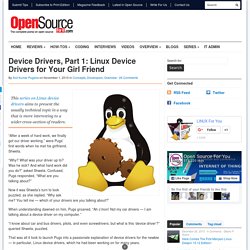
“After a week of hard work, we finally got our driver working,” were Pugs’ first words when he met his girlfriend, Shweta. “Why? What was your driver up to? Was he sick? And what hard work did you do?” Now it was Shweta’s turn to look puzzled, as she replied, “Why ask me? When understanding dawned on him, Pugs groaned, “Ah c’mon! “I know about car and bus drivers, pilots, and even screwdrivers; but what is this ‘device driver’?” That was all it took to launch Pugs into a passionate explanation of device drivers for the newbie — in particular, Linux device drivers, which he had been working on for many years.
Of drivers and buses A driver drives, manages, controls, directs and monitors the entity under its command. Introduction to Linux Kernel. What is Kernel?
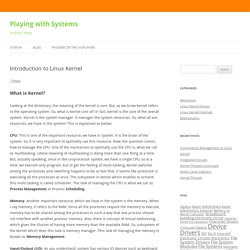
Looking at the dictionary, the meaning of the kernel is core. But, as we know kernel refers to the operating system. So, what is kernel core of? In fact, kernel is the core of the overall system. Kernel is the system manager. CPU: This is one of the important resource, we have in system. Memory: Another important resource, which we have in the system is the memory. Input/Output (I/O): As you understand, system has various IO devices such as keyboard, mice, and speakers and so on. Storage: This resource is used for storing the data in the non-volatile memory such as hard-disk. Network: In order to communication across the systems, we require the network.
Embedded Linux Experts - Free Electrons. Embedded Linux, kernel and real-time presentations. Free training materials and conference presentations from Free Electrons, covering kernel, real-time, Android, embedded Linux system and device driver development.
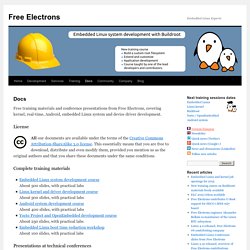
License All our documents are available under the terms of the Creative Commons Attribution-ShareAlike 3.0 license. This essentially means that you are free to download, distribute and even modify them, provided you mention us as the original authors and that you share these documents under the same conditions. Complete training materials Presentations at technical conferences Here are the most recent versions of presentations we made at technical conferences.
Linux kernel An overview of the DMAEngine subsystem (ELC, Mar. 2015) Understanding the DMAEngine subsystem in the Linux kernelDevice Tree as a stable ABI: a fairy tale? Embedded Linux Android Introduction to Android and system bring-up (Captronic events, 2012) Legacy documents These documents are not actively maintained any more. Kernel Architecture specific documents Miscellaneous. Linux Today - Linux News On Internet Time. Linux concepts Archives. Character vs. block devices. Next: Interrupts vs.
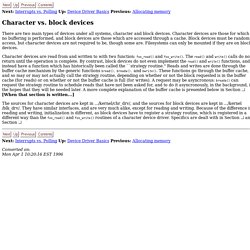
PollingUp: Device Driver Basics Previous: Allocating memory There are two main types of devices under all systems, character and block devices. Character devices are those for which no buffering is performed, and block devices are those which are accessed through a cache. Block devices must be random access, but character devices are not required to be, though some are. Filesystems can only be mounted if they are on block devices. Character devices are read from and written to with two function: foo_read() and foo_write(). [When that section is written...] The sources for character devices are kept in ... Block Device Drivers. The HyperNews Linux KHG Discussion Pages Block Device Drivers [Note: This has not been updated since changes were made in the block device interface to support block device loadable modules.
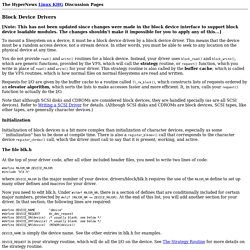
The changes shouldn't make it impossible for you to apply any of this...] To mount a filesystem on a device, it must be a block device driven by a block device driver. This means that the device must be a random access device, not a stream device. You do not provide read() and write() routines for a block device. Requests for I/O are given by the buffer cache to a routine called ll_rw_block(), which constructs lists of requests ordered by an elevator algorithm, which sorts the lists to make accesses faster and more efficient.
Article Series on Linux Device Drivers. SysPlay eLearning Academy for You.